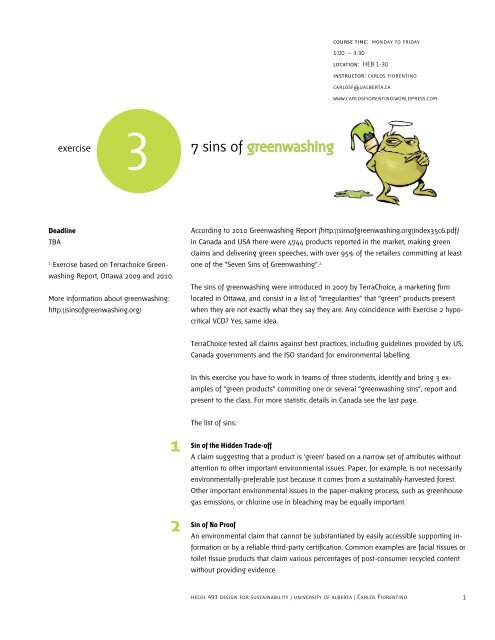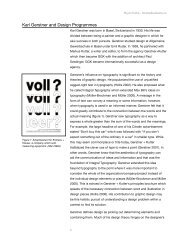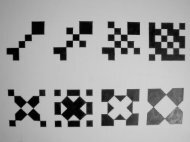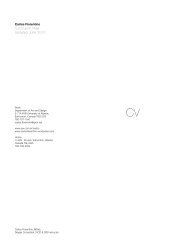3-7sins - Carlos Fiorentino
3-7sins - Carlos Fiorentino
3-7sins - Carlos Fiorentino
Create successful ePaper yourself
Turn your PDF publications into a flip-book with our unique Google optimized e-Paper software.
course time: monday to friday<br />
1:00 – 3:30<br />
location: HEB 1-30<br />
instructor: carlos fiorentino<br />
carlosf@ualberta.ca<br />
www.carlosfiorentino.worldpress.com<br />
exercise<br />
3<br />
7 sins of greenwashing<br />
Deadline<br />
TBA<br />
1.<br />
Exercise based on Terrachoice Greenwashing<br />
Report, Ottawa 2009 and 2010.<br />
More information about greenwashing:<br />
http://sinsofgreenwashing.org/<br />
According to 2010 Greenwashing Report (http://sinsofgreenwashing.org/index35c6.pdf)<br />
in Canada and USA there were 4744 products reported in the market, making green<br />
claims and delivering green speeches, with over 95% of the retailers committing at least<br />
one of the “Seven Sins of Greenwashing”. 1.<br />
The sins of greenwashing were introduced in 2007 by TerraChoice, a marketing firm<br />
located in Ottawa, and consist in a list of “irregularities” that “green” products present<br />
when they are not exactly what they say they are. Any coincidence with Exercise 2 hypocritical<br />
VCD? Yes, same idea.<br />
TerraChoice tested all claims against best practices, including guidelines provided by US,<br />
Canada governments and the ISO standard for environmental labelling.<br />
In this exercise you have to work in teams of three students, identify and bring 3 examples<br />
of “green products” commiting one or several “greenwashing sins”, report and<br />
present to the class. For more statistic details in Canada see the last page.<br />
1<br />
2<br />
The list of sins:<br />
Sin of the Hidden Trade-off<br />
A claim suggesting that a product is ‘green’ based on a narrow set of attributes without<br />
attention to other important environmental issues. Paper, for example, is not necessarily<br />
environmentally-preferable just because it comes from a sustainably-harvested forest.<br />
Other important environmental issues in the paper-making process, such as greenhouse<br />
gas emissions, or chlorine use in bleaching may be equally important.<br />
Sin of No Proof<br />
An environmental claim that cannot be substantiated by easily accessible supporting information<br />
or by a reliable third-party certification. Common examples are facial tissues or<br />
toilet tissue products that claim various percentages of post-consumer recycled content<br />
without providing evidence.<br />
hecol 493 design for sustainability | university of alberta | <strong>Carlos</strong> <strong>Fiorentino</strong> 1
3<br />
4<br />
5<br />
6<br />
7<br />
Sin of Vagueness<br />
A claim that is so poorly defined or broad that its real meaning is likely to be misunderstood<br />
by the consumer. ‘All-natural’ is an example. Arsenic, uranium, mercury, and formaldehyde<br />
are all naturally occurring, and poisonous. ‘All natural’ isn’t necessarily ‘green’.<br />
Sin of Worshiping False Labels<br />
A product that, through either words or images, gives the impression of third-party endorsement<br />
where no such endorsement exists; fake labels, in other words.<br />
Sin of Irrelevance<br />
An environmental claim that may be truthful but is unimportant or unhelpful for consumers<br />
seeking environmentally preferable products. ‘CFC-free’ is a common example,<br />
since it is a frequent claim despite the fact that CFCs are banned by law.<br />
Sin of Lesser of Two Evils<br />
A claim that may be true within the product category, but that risks distracting the<br />
consumer from the greater environmental impacts of the category as a whole. Organic<br />
cigarettes could be an example of this Sin, as might the fuel-efficient sport-utility vehicle.<br />
Sin of Fibbing<br />
Environmental claims that are simply false. The most common examples were products<br />
falsely claiming to be Energy Star certified or registered.<br />
hecol 493 design for sustainability | university of alberta | <strong>Carlos</strong> <strong>Fiorentino</strong> 2





